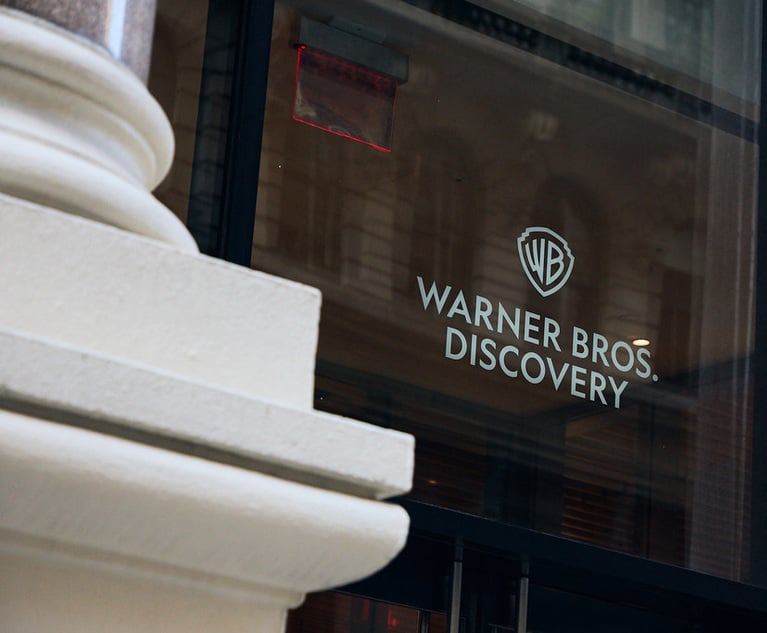IP: Nontraditional Trademarks
Companies can protect their products' unique features from infringers
September 13, 2010 at 08:00 PM
8 minute read
The original version of this story was published on Law.com
 Recent research indicates that consumer reactions to nontraditional trademarks, such as a product's unique shape, or its distinctive appearance, are exceedingly strong and may create more zealous consumer loyalty than traditional marks, such as brand names and logos, alone. In addition to shape and appearance, nontraditional trademarks provide protection for such attributes as colors, sounds, tactile impressions, and even flavors and scents. Although they are generally more difficult to register and enforce than traditional word and logo trademarks, nontraditional trademarks can help companies protect their products' unique attributes.
Recent research indicates that consumer reactions to nontraditional trademarks, such as a product's unique shape, or its distinctive appearance, are exceedingly strong and may create more zealous consumer loyalty than traditional marks, such as brand names and logos, alone. In addition to shape and appearance, nontraditional trademarks provide protection for such attributes as colors, sounds, tactile impressions, and even flavors and scents. Although they are generally more difficult to register and enforce than traditional word and logo trademarks, nontraditional trademarks can help companies protect their products' unique attributes.
By definition, a trademark indicates source and identifies and distinguishes the products of one entity from others' products. This definition allows that any subject matter, perceived by one or more of the five senses, not just words and logos, may serve as a trademark as long as it identifies, distinguishes and indicates source. Many nontraditional trademarks, such as the appearance of an Apple iPod or a Heinz ketchup bottle, the color of a Tiffany's box, or the sound of the Intel chimes or of McDonalds' “I'm lovin' it” jingle, have indeed become instantly recognizable as source identifiers, even without reference to the respective word or logo trademarks.
Nontraditional trademarks, however, are often met with skepticism by the courts and the U.S. Patent and Trademark Office. So additional organizational commitment and coordination between a company's business people and its trademark counsel are often required to identify and develop protectable nontraditional marks.
Indeed, a company should consider several factors before investing in a nontraditional trademark. Of course, a company must first ensure that its adoption and use of the nontraditional trademark will not infringe another company's existing rights. Additionally, any attempt to build trademark rights in a product feature will fail if the product feature is “functional.” Functional features are features that are essential to the use or purpose of the product or that affect the cost or quality of the product, or that, if protected as trademarks, would put competitors at a significant “non-reputation-related” disadvantage. For example, scent is a functional feature when used in connection with air fresheners, but plumeria scented yarn, bubble-gum scented industrial metal working fluid, and cherry-scented auto exhaust have been awarded trademark registrations. Meanwhile, a court has held the color black functional for outboard motors, while Boise State University's exclusive right to blue football field turf is protected with a federal trademark registration.
In addition, courts will not enforce, and the USPTO will not register, certain nontraditional trademarks, including product shapes, colors, scents and probably flavor marks, without proof that the asserted nontraditional mark actually indicates source to consumers. Hard evidence must demonstrate that these nontraditional marks have acquired the distinctiveness necessary to function as trademarks. Trademark owners can proactively address this issue. For example, a company's advertising can focus consumer attention on the nontraditional trademark with “look for” advertising. This advertising can be blatant, or it can be subtle, such as United Parcel Service's “What can brown do for you?” advertisements which helped cement the color brown as a distinctive source identifier for UPS' services. Evidence such as consumer perception surveys, long-standing use of the nontraditional mark, overall advertising expenses and sales revenue relating to the nontraditional mark can also demonstrate that the mark has acquired distinctiveness.
The benefits of obtaining a federal registration for a nontraditional mark are substantial, including presumptions of nationwide exclusivity, prima facie validity and the eventual opportunity to obtain “incontestable” status, yet a registration may provide little certainty that an action to enforce a nontraditional mark will be successful. As with traditional word or logo marks, a trademark owner must prove a likelihood of confusion exists between its mark and the infringing mark to successfully enforce the nontraditional mark. Proving a likelihood of confusion between competing scent marks or competing flavor marks may prove relatively complex, however.
While nontraditional marks can be relatively difficult to register and enforce, the difficulties and uncertainties can be minimized with careful selection, planning and commitment. Moreover, nontraditional trademarks can provide an important means to protect a company's distinctive product features and an important branding tool to further connect with consumers.
Read Christopher Dolan's previous column. Read Christopher Dolan's next column.
 Recent research indicates that consumer reactions to nontraditional trademarks, such as a product's unique shape, or its distinctive appearance, are exceedingly strong and may create more zealous consumer loyalty than traditional marks, such as brand names and logos, alone. In addition to shape and appearance, nontraditional trademarks provide protection for such attributes as colors, sounds, tactile impressions, and even flavors and scents. Although they are generally more difficult to register and enforce than traditional word and logo trademarks, nontraditional trademarks can help companies protect their products' unique attributes.
Recent research indicates that consumer reactions to nontraditional trademarks, such as a product's unique shape, or its distinctive appearance, are exceedingly strong and may create more zealous consumer loyalty than traditional marks, such as brand names and logos, alone. In addition to shape and appearance, nontraditional trademarks provide protection for such attributes as colors, sounds, tactile impressions, and even flavors and scents. Although they are generally more difficult to register and enforce than traditional word and logo trademarks, nontraditional trademarks can help companies protect their products' unique attributes.
By definition, a trademark indicates source and identifies and distinguishes the products of one entity from others' products. This definition allows that any subject matter, perceived by one or more of the five senses, not just words and logos, may serve as a trademark as long as it identifies, distinguishes and indicates source. Many nontraditional trademarks, such as the appearance of an
Nontraditional trademarks, however, are often met with skepticism by the courts and the U.S. Patent and Trademark Office. So additional organizational commitment and coordination between a company's business people and its trademark counsel are often required to identify and develop protectable nontraditional marks.
Indeed, a company should consider several factors before investing in a nontraditional trademark. Of course, a company must first ensure that its adoption and use of the nontraditional trademark will not infringe another company's existing rights. Additionally, any attempt to build trademark rights in a product feature will fail if the product feature is “functional.” Functional features are features that are essential to the use or purpose of the product or that affect the cost or quality of the product, or that, if protected as trademarks, would put competitors at a significant “non-reputation-related” disadvantage. For example, scent is a functional feature when used in connection with air fresheners, but plumeria scented yarn, bubble-gum scented industrial metal working fluid, and cherry-scented auto exhaust have been awarded trademark registrations. Meanwhile, a court has held the color black functional for outboard motors, while Boise State University's exclusive right to blue football field turf is protected with a federal trademark registration.
In addition, courts will not enforce, and the USPTO will not register, certain nontraditional trademarks, including product shapes, colors, scents and probably flavor marks, without proof that the asserted nontraditional mark actually indicates source to consumers. Hard evidence must demonstrate that these nontraditional marks have acquired the distinctiveness necessary to function as trademarks. Trademark owners can proactively address this issue. For example, a company's advertising can focus consumer attention on the nontraditional trademark with “look for” advertising. This advertising can be blatant, or it can be subtle, such as
The benefits of obtaining a federal registration for a nontraditional mark are substantial, including presumptions of nationwide exclusivity, prima facie validity and the eventual opportunity to obtain “incontestable” status, yet a registration may provide little certainty that an action to enforce a nontraditional mark will be successful. As with traditional word or logo marks, a trademark owner must prove a likelihood of confusion exists between its mark and the infringing mark to successfully enforce the nontraditional mark. Proving a likelihood of confusion between competing scent marks or competing flavor marks may prove relatively complex, however.
While nontraditional marks can be relatively difficult to register and enforce, the difficulties and uncertainties can be minimized with careful selection, planning and commitment. Moreover, nontraditional trademarks can provide an important means to protect a company's distinctive product features and an important branding tool to further connect with consumers.
Read Christopher Dolan's previous column. Read Christopher Dolan's next column.
This content has been archived. It is available through our partners, LexisNexis® and Bloomberg Law.
To view this content, please continue to their sites.
Not a Lexis Subscriber?
Subscribe Now
Not a Bloomberg Law Subscriber?
Subscribe Now
NOT FOR REPRINT
© 2025 ALM Global, LLC, All Rights Reserved. Request academic re-use from www.copyright.com. All other uses, submit a request to [email protected]. For more information visit Asset & Logo Licensing.
You Might Like
View All


SEC Puts Beat Down on Ex-Wrestling CEO Vince McMahon for Not Reporting Settlements
3 minute readTrending Stories
- 1'It's Not Going to Be Pretty': PayPal, Capital One Face Novel Class Actions Over 'Poaching' Commissions Owed Influencers
- 211th Circuit Rejects Trump's Emergency Request as DOJ Prepares to Release Special Counsel's Final Report
- 3Supreme Court Takes Up Challenge to ACA Task Force
- 4'Tragedy of Unspeakable Proportions:' Could Edison, DWP, Face Lawsuits Over LA Wildfires?
- 5Meta Pulls Plug on DEI Programs
Who Got The Work
Michael G. Bongiorno, Andrew Scott Dulberg and Elizabeth E. Driscoll from Wilmer Cutler Pickering Hale and Dorr have stepped in to represent Symbotic Inc., an A.I.-enabled technology platform that focuses on increasing supply chain efficiency, and other defendants in a pending shareholder derivative lawsuit. The case, filed Oct. 2 in Massachusetts District Court by the Brown Law Firm on behalf of Stephen Austen, accuses certain officers and directors of misleading investors in regard to Symbotic's potential for margin growth by failing to disclose that the company was not equipped to timely deploy its systems or manage expenses through project delays. The case, assigned to U.S. District Judge Nathaniel M. Gorton, is 1:24-cv-12522, Austen v. Cohen et al.
Who Got The Work
Edmund Polubinski and Marie Killmond of Davis Polk & Wardwell have entered appearances for data platform software development company MongoDB and other defendants in a pending shareholder derivative lawsuit. The action, filed Oct. 7 in New York Southern District Court by the Brown Law Firm, accuses the company's directors and/or officers of falsely expressing confidence in the company’s restructuring of its sales incentive plan and downplaying the severity of decreases in its upfront commitments. The case is 1:24-cv-07594, Roy v. Ittycheria et al.
Who Got The Work
Amy O. Bruchs and Kurt F. Ellison of Michael Best & Friedrich have entered appearances for Epic Systems Corp. in a pending employment discrimination lawsuit. The suit was filed Sept. 7 in Wisconsin Western District Court by Levine Eisberner LLC and Siri & Glimstad on behalf of a project manager who claims that he was wrongfully terminated after applying for a religious exemption to the defendant's COVID-19 vaccine mandate. The case, assigned to U.S. Magistrate Judge Anita Marie Boor, is 3:24-cv-00630, Secker, Nathan v. Epic Systems Corporation.
Who Got The Work
David X. Sullivan, Thomas J. Finn and Gregory A. Hall from McCarter & English have entered appearances for Sunrun Installation Services in a pending civil rights lawsuit. The complaint was filed Sept. 4 in Connecticut District Court by attorney Robert M. Berke on behalf of former employee George Edward Steins, who was arrested and charged with employing an unregistered home improvement salesperson. The complaint alleges that had Sunrun informed the Connecticut Department of Consumer Protection that the plaintiff's employment had ended in 2017 and that he no longer held Sunrun's home improvement contractor license, he would not have been hit with charges, which were dismissed in May 2024. The case, assigned to U.S. District Judge Jeffrey A. Meyer, is 3:24-cv-01423, Steins v. Sunrun, Inc. et al.
Who Got The Work
Greenberg Traurig shareholder Joshua L. Raskin has entered an appearance for boohoo.com UK Ltd. in a pending patent infringement lawsuit. The suit, filed Sept. 3 in Texas Eastern District Court by Rozier Hardt McDonough on behalf of Alto Dynamics, asserts five patents related to an online shopping platform. The case, assigned to U.S. District Judge Rodney Gilstrap, is 2:24-cv-00719, Alto Dynamics, LLC v. boohoo.com UK Limited.
Featured Firms
Law Offices of Gary Martin Hays & Associates, P.C.
(470) 294-1674
Law Offices of Mark E. Salomone
(857) 444-6468
Smith & Hassler
(713) 739-1250







